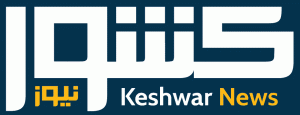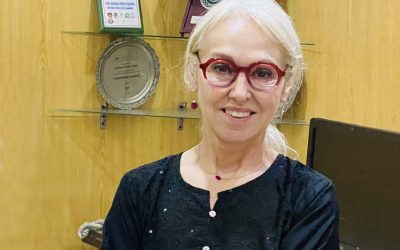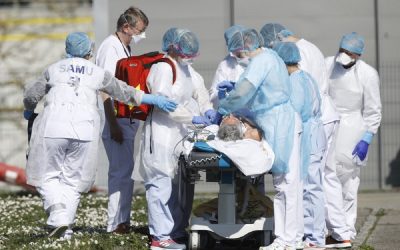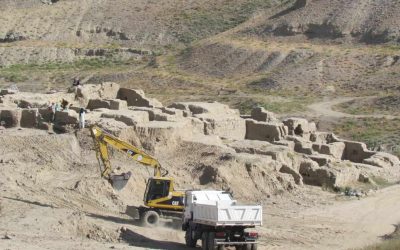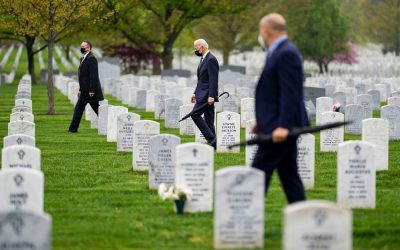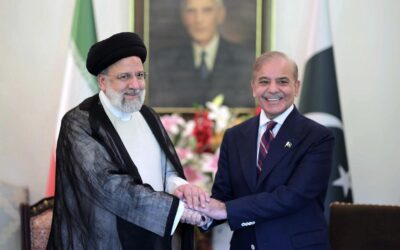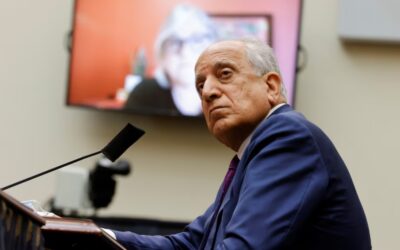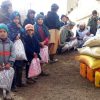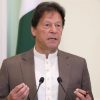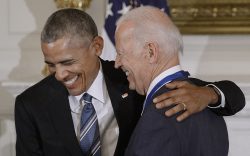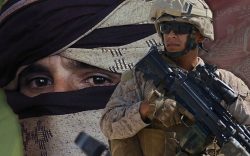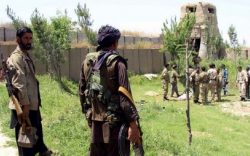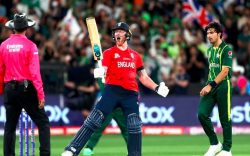
AAN Obituary: PDPA Leader and Poet Sulaiman Layeq (1930-2020)
20 August 2020
Afghanistan-analysts
Sulaiman Layeq, one of the last surviving founding members of the leftist People’s Democratic Party of Afghanistan (PDPA), which changed the country’s history with its coup d’état in 1978, has died in late July. In 1992, he even made it to the top of the party, albeit in its final moments. The circumstances of his death were tragic and symbolic for the state of Afghanistan at the same time: Layeq, 90 years old, died of the wounds he had sustained in a suicide bombing in September 2019 in Kabul. AAN’s co-director Thomas Ruttig looks back at the two sides of his life – the life of a highly esteemed poet and of a controversial politician.
Layeq was in his car when an attacker detonated explosives in a van nearby, killing 12 people in Kabul’s Shashdarak area on 5 September 2019, as the New York Times reported then. The victims were mainly passers-by. Two passengers in a military SUV, the attacker’s target, were also killed: a Romanian and a US soldier. The Times report described how Layeq was left “deeply dazed and bleeding badly,” how soldiers were “trying to pry open the door to Mr. Layeq’s car,” how “one emergency worker in a white coat reached in through a window to help stanch his bleeding until he was freed from the car” and, finally, a soldier lifting him “onto his back, rushing him to an ambulance.”
US President Donald Trump took this attack as an opportunity to call off negotiations with the Taleban, saying “What kind of people would kill so many in order to seemingly strengthen their bargaining position?” – temporarily, as we know now (AAN reporting here and on the 29 February 2020 US-Taleban agreement here.)
On 31 July 2020, Layeq died in a hospital in Germany. Tolonews claimed he was also infected with the coronavirus.
From tribal Paktia to modernising Kabul
Layeq was born on 21 Tela/Mizan 1309 (13 October 1930) (1) in Sharana, then in southeastern Paktia province, today Paktika’s provincial capital. Layeq’s political career as a leftist was not a family inheritance. His father Abdul Ghani (d. 1979) was a religious tribal figure in Sharana. He fought against the British in the 1919 war of independence (AAN background here). The family belonged to the Minzai branch of the Sulaimankhel Pashtuns and the father was a khalifa (local representative) of the Naqshbandi Sufi order. In Afghanistan, this spiritual brotherhood was led by the influential Mujaddedi family of religious scholars. Accordingly, Abdul Ghani named his son Ghulam Mujadded (servant of the Mujadded), indicating that he aspired to a religious career for his son, too.
According to Chris Sands and Fazelminallah Qazizai’s 2019 book Night Letters: Gulbuddin Hekmatyar and the Afghan Islamists Who Changed the World (Hurst, London), Layeq’s father was lured to Kabul by Prime Minister Muhammad Hashem when his son was five, ie in 1935. Hashem made the father his personal imam for the next 17 years. Layeq at first seems to have been privately educated, mainly in classical Persian literature. This made him a prolific and celebrated poet and writer not only in his native Pashto but also in Afghanistan’s other main language, Dari/Farsi. In various interviews, he cited the great 14th century Persian-language poet Hafez from Shiraz and Arab scholar Ibn Khaldun as his earliest and strongest influences.
In 1319 (1940) his father enrolled him in the prestigious Habibia high school. In 1326 (1947), he shifted to a state-run madrasa in Paghman. There, he changed his name to Sulaiman, the one his mother (who had died in his childhood from cholera) wanted to give him, and to Layeq (the gifted one), a name one of his ancestors, according to Ludwig W Adamec’s 1987 Biographical Dictionary of Contemporary Afghanistan. The name change was a sign of his leaving his father’s religious ideas behind and of his new political thinking.
James Caron of the University of London’s School of Oriental and African Studies, a specialist on Pashto culture and Pashtun politics, wrote (p3) that Layeq traced his “specific politics to internationalism; but in examining his own activist impulse, he cites his childhood on the Indo-Afghan border in a pastoralist Mulla family who were embedded in activist devotional networks.” Layeq in an interview also spoke about the poverty he experienced in the tribal society of his childhood and the injustices during his school years.
From sharia studies to the red “banner”
After four years, in 1331 (1951), Layeq was relegated from the madrasa. According to Kabul-based journalist Samad Samad, he had led its students in protest demonstrations and a hunger strike against the school’s superintendence and staff because of the physical and sexual harassment of students. After his release, his father used his connections to make sure he could return to the madrasa and graduate.
The following year, still in accordance with his father’s wishes, he enrolled at the sharia faculty at Kabul University. That same year, he was expelled there, too, after having participated in anti-government student protests. It was the time of the Wesh Zalmian/Jawanan-e Bedar reformist movement and the Students’ Union at Kabul University that were pushing for modernisation of the Afghan monarchy and what they saw as a stagnant political system (for background, see AAN reports here and here). In those years, he wrote poems supporting modernist opposition candidates, such as Dr Abdul Rahman Mahmudi (find a poem here).
Two years later, in 1334 (1955), Layeq was readmitted, but this time at the literature and philosophy department at the university’s faculty of letters, from which he graduated in 1336 (1957). He started working as a journalist at the government’s publication directorate in 1958, writing for the government-owned Hewad daily first, then as head of the department for education and literature with Radio Afghanistan from 1959 to 1965 and directly for the Ministry of Information and Culture from 1965 to 1967. He also wrote for the well-read cultural magazine Zhwandun (Life).
This also seemed to have been the time when he became more politically active, beyond student protests. Journalists and writers had a number of meeting points, among them the Bacha-ye Shahqul’s (son of Shahqul’s) Café. This is where he is reported to have met Mir Akbar Khaibar for the first time, the PDPA’s later leading ideologue, who had studied at Kabul’s Military Academy and who had been jailed for Wesh Zalmian-related activity, the public protests and the government crackdown before the 1952 parliamentary polls. Members of the military were banned from being politically active. This must have been around 1956.
At that time, the first small political discussion circles, called mahfel, started emerging. After the 1963 constitution came into force, opening the door for political parties to be legalised, some of them evolved into parties. (2) Some merged into leftist Jamiat-e Dimukratik-e Khalq-e Afghanistan (People’s Democratic Association of Afghanistan, PDPA) in 1965. After the 1978 military coup, it ruled the country under the name Hezb-e Dimukratik-e Khalq-e Afghanistan (“party”). Khaibar is said to have organised one of the first mahfels, and it can be assumed that Layeq participated.
When the PDPA was established on 1 January 1965 at party leader Nur Muhammad Tarakay’s house in western Kabul, Layeq was one of the 27 participants of what the party’s official history called its ‘founding congress’. Layeq, though, was not yet elected a member of the seven-member leading body, the Central Committee (CC). In 1966, he became an alternate CC member. When the party split into two factions in 1967 over personal rivalries and political differences, Khalq (People) and Parcham (Banner), he went with Khaibar to Parcham.
Both also became the co-editors of the faction’s homonymous newspaper that appeared between March 1968 and July 1969 (or even 1970, according to some sources). The original PDPA paper, also called Khalq, had been banned after only six issues appearing in April and May 1966 as it too openly appeared as the printing organ of a party that, until then, had not been legalised.
In 1965 and 1969, Layeq ran unsuccessfully for parliament from Pul-e Khumri, the capital of Baghlan province. This was his father’s place of exile to which he had been banished after losing his job with prime minister Hashem who had been replaced in 1946 by his half-brother, the more modernist Shah Mahmud. Shah Mahmud allowed the first halfway democratic (ie not government-manipulated) parliamentary elections, but still not with party lists. Layeq, as everyone else, ran as an ‘independent’ although the affiliations of those who had one were widely known. During his second campaign, leaflets (so-called night letters, shabname) were distributed in Baghlan denouncing him as an apostate for his work for the PDPA’s Parcham newspaper. One was sent to his father who was not amused. The leaflets came from a group of Islamist activists around Gulbuddin Hekmatyar, according to Sands/Qazizai. The group later would evolve into the major Hezb-e Islami mujahedin party, with Hekmatyar as its leader. It was fighting the Soviets in the 1980s and the post-2001 US-led intervention. (3)
Layeq also mingled among other political circles. According to a biography of Mawlawi Yunos Khales by Haji Din Muhammad, both important mujahedin leaders in the 1980s (quoted by Kevin Bell in a paper for West Point’s Combatting Terrorism Center, p16), “early gatherings [of the newly emerging Islamist movement, Jawanan-e Musalman, ie Muslim Youth] actually included socialist activists and thinkers.” Layeq’s sharia studies and family relations may have helped him to become accepted there. Family ties, too linked him with this opposing camp. While one of his sisters was married to Khaibar – a marriage said to have been arranged by Layeq himself – his other sister was the wife of Sebghatullah Mujaddedi who would later become mujahedin leader and interim president in 1992, surely on his father’s initiative (AAN background here).
Layeq kept looking beyond his own political circles after 2001 when this author saw him at a Hezb-e Islami congress, then led by Abdul Hadi Arghandehwal who later broke ranks with Hekmatyar (AAN background here).
Office, jail and office again under the PDPA
Ten days before the military coup in late April 1978 that brought the PDPA to power, Layeq’s mentor, Khaibar, was murdered under circumstances unclear to this day. (Layeq himself had indicated to Sands/Qazizai that a “circle in the party [ie the PDPA]” itself which had been aiming for a military takeover was responsible for the killing, knowing that Khaibar would have rejected this as a way to gain power. He later indicated the involvement of Nur Ahmad Nur who became a PDPA Polit Bureau member after 1978.)
When the PDPA brought tens of thousands into the street for the funeral that turned into a protest march against the government, President Muhammad Daud (1973-78) had the party leaders arrested. Layeq claimed he turned himself in voluntarily as he did not want to be treated differently to the others. Hafizullah Amin, the leader of the Khalq faction’s underground military network, meanwhile, was still able to trigger the military coup led by pro-PDPA officers before his own arrest. Layeq and the others were released immediately after the successful coup and drove directly to Radio Afghanistan to announce the victory of the revolution. Layeq became Minister for Radio and TV in the first PDPA cabinet. (4)
Layeq had moved into the party’s CC and its key Polit Bureau by then, most likely when Khalq and Parcham, still underground, reunified in 1977. This happened under Soviet prompting and with mediation by the Iraqi and Indian communist parties and leaders of the leftist, mainly Pashtun, Awami National Party (ANP) in Pakistan. (5) He was also the director of Pul-e Khumri’s textile plant, one of the few larger industrial enterprises in the country, according to Anthony Arnold’s 1983 book Afghanistan’s Two-Party Communism (p55), a position through which the Soviets funnelled funds to the party via official business contracts. (Sands/Qazizai apparently did not ask Layeq to comment about this, at least there is no statement from him in their book.)
Party unity did not last long. The Khalqis under Tarakay, the new head of state, and his deputy Hafizullah Amin accused the Parchamis of plotting against them in the summer of 1978. By November that year, their most important leaders had either been sent to jail or abroad on ambassadorial posts that most of them (including later party leader Najibullah) quickly left behind to go into exile. Layeq at first only lost his ministry and his seat on the Polit Bureau in November 1978. In March 1979, he was arrested, sentenced to death and put in Kabul’s Pul-e Charkhi jail. From there, he was liberated after the Soviet invasion over Christmas 1979 that brought the Parchamis back to power (find background in this AAN dossier). (6)
Layeq was reinstalled to party and state offices. First, he was appointed to chair the country’s Academy of Sciences in April 1980. He also returned to the PDPA CC as an alternate member and was appointed deputy chairman of the National Fatherland Front. (7) More importantly, he was made Minister for Tribal and Border Affairs from its re-establishment in 1981 until 1989.
In 1985 and 1986, when Najibullah, the head of the Afghan intelligence service, was made leader of the party and state president respectively, Layeq’s ministry became important for Najibullah’s (and Gorbachov’s) policy of national reconciliation. This new political course aimed to win over some of the mujahedin, the so-called ‘reconcilable’ ones, for a power sharing deal. In the party, he rose to top ranks in the Polit Bureau, first as an alternate member in 1985 and as a full member in 1986. This combination gave Layeq a key political role. When Najibullah renamed the leftist PDPA “Hezb-e Watan” (Homeland Party) and dropped most of the party’s leftist politics in 1990 (AAN background here), Layeq became one of its three deputy leaders.
In this capacity, using his good contacts with the Pashtun tribes and Pashtun politicians in Pakistan, Layeq would talk with tribal elders in order to persuade them to work on mujahedin fighters from their communities to lay down arms. In 1989, as Layeq told Sands/Qazizai (pp244ff), he led two negotiation teams that held talks with representatives of Hezb-e Islami in Baghdad and Tripoli, arranged by PLO chief Yaser Arafat and the Libyan leadership, about a separate truce with Hezb. Both attempts failed, as did a mission he led to the United States in early 1992. He also claimed to Sands/Qazizai (p236) that it was him who suggested to the Soviets that they cut a deal with mujahedin leader Ahmad Shah Massud. (8)
According to some sources such as Fred Halliday (“Soviet foreign policymaking and the Afghanistan war: from ‘second Mongolia’ to ‘bleeding wound“, 1999, p683) – and confirmed during a meeting with this author in his book-filled flat in Kabul’s Microrayon some years ago, Layeq himself could have made it to the very top of the party in 1985.
One day in October that year, as Layeq recalled, “there was a knock on my apartment’s door very early in the morning. I was still in my pyjamas. There was a Soviet advisor telling me to get dressed and come to the airport.” He was put on an airplane together with most of the PDPA leaders, and, after having suffered a many hours-long wait without even being served tea, they were brought before Mikhail Gorbachov. The new Soviet leader told them about the not yet official decision to withdraw the troops from Afghanistan and urged them to seek a power-sharing deal with the mujahedin, which then turned into the policy of national reconciliation. Babrak Karmal, who had come to the top of the PDPA and the government as a result of the Soviet invasion in 1979, was forced to step down as party head. Finally, as it became obvious then, the Soviets opted for Najibullah to replace him instead for Layeq.
When the regime fell apart as a result of defections triggered by Russia halting financial and economic aid in 1992, Layeq and Najibullah fell out with each other, at least politically. Layeq was critical of Najibullah’s unilateral decision to try to leave the country without informing the party’s leadership. (9) In the words of Zaher Tanin, a doctor, journalist and Hezb-e Watan CC member-turned-BBC journalist and later Afghanistan’s ambassador to the UN under Karzai, and his co-author Halliday (“The communist regime in Afghanistan 1978–1992: Institutions and conflicts“, 1998, pp1371-1380):
Laiq was one of Najib’s closest friends and, by all accounts, his real mentor. He […] finally distanced himself from Najib and joined his opponents. Laiq and Abdul Wakil were the only party leaders who on TV denounced Najib as a traitor after his failed attempt to leave the country.
This was also reported by the Los Angeles Times from Kabul on 19 April that year.
This episode finally brought Layeq to the top of the party, albeit in its dying moments. According to him, he was made the new party leader after it was decided that Najibullah was to step down from all positions under a UN power-sharing plan with the mujahedin as he had been the oldest leader remaining. Layeq said in a 2016 interview that he still considered himself to be the party leader, as “no party organ has made me redundant.”
Exile and return
After the collapse of the regime, Layeq, who had sent his family to Germany, hid in Afghanistan. After two months, he once said in an interview, he accompanied a group of former comrades who had approached him for help (ie tribal links) to cross into Pakistan, to Peshawar. The story he told Sands/Qazizai sounded less heroic: He took a bus to Pakistan, fearing he might be discovered at the various mujahedin check-posts along the way, and was accommodated in a guest house belonging to his political friends in the Awami National Party. From there, he joined his family in Germany. In the 2016 interview he insisted that he never asked for asylum and lived there with his Afghan passport and an unlimited visa, which allowed him to travel back and forth. Most family members had been granted asylum in Germany, except his son Gharzai Layeq, who was granted asylum in the Netherlands.
In and from Germany, Layeq was involved in a number of attempts to reunite the diverse parties and factions founded by former members of the disintegrated PDPA/Watan Party. (There are around 25 among Afghanistan’s registered parties and many more unregistered.) None of them succeeded, neither before nor after 2001. (Read this paper by the author for more detail.) Layeq returned to Afghanistan after the fall of the Taleban in 2001 and worked as a scientific advisor to the head of the Academy of Science. He also advised UNAMA and Aref Nurzai, minister of and presidential advisor for tribal affairs (2002-04 and 2009-12).
When finally a new Hezb-e Watan was established (although never registered) by former pro-PDPA militia commander-turned-Ghani ally, late Abdul Jabbar Qahraman in Kabul in 2017 (AAN background here), Layeq told AAN:
I was not consulted about the initiative. Otherwise, I would have attended the meeting. My position towards all Hezb-e Watan factions is similar: I do not belong to them but I am supportive of them. I am against those groups who terrorise, loot and kill our countrymen.
On another occasion he said he wanted the party reunited, but with a “thoroughly reviewed programme.”
Layeq and the PDPA’s past
For his role as a PDPA/Watan leader Layeq is despised by many. Sands/Qazizai called him “the regime’s propaganda master.” This seems to be exaggerated, as he only served as radio/TV minister for less than a year before being thrown in jail for an alleged conspiracy. But it was also during a period when Tarakay, the head of state and party, considered Lenin’s “Red Terror” as a way to follow in defence of the Afghan revolution. He was quoted as saying:
Lenin taught us to be merciless towards the enemies of the revolution and millions of people had to be eliminated in order to secure the victory of the October Revolution.
Kabul-based journalist Asad Kosha, in his Layeq obituary for the news portal Kabul Now on 3 August 2020, more modestly spoke of his “inspiring poetry [that] contributed much to a revolutionary rhetoric in political debate raised by the Parcham faction.”
After Tarakay’s assassination, Amin’s overthrow and the Soviet invasion, Layeq had no formal responsibility for propaganda in the party leadership (this was with others in the Polit Bureau) and was not a high profile figure until 1985/86. In his later, more influential, positions in the Polit Bureau and as a minister, however, he was to carry political co-responsibility for the PDPA/Watan’s doings, which included war crimes and mass human rights violations. He later distanced himself from what he called ‘exaggerations’ and ‘radicalism’ in the party’s policies and, quoting the 11th century Herati Sufi, Sheikh Khwaja Abdullah Ansari, said his party wanted to be “ahead of our time and put ourselves above the law” (az waqt pesh khwahem wa az haq besh). He even claimed in the 2016 interview that he had opposed the Soviet invasion. (10) But he never clearly condemned these crimes. He also refused to give up his communist ideology. In the same interview he said that he believed that “socialism is the world’s future, but not the socialism we have seen.”
The furthest Layeq went was saying on a TV panel broadcast by state-owned RTA in cooperation with the BBC in January 2013, as quoted by its moderator, Daud Jombesh:
… that he personally supported tribunals [in the framework of transitional justice]: “It could start with me. I volunteer. A nation has been sacrificed. A nation has sustained damages. It would be good to see who the perpetrators are: who is guilty and who made such bloody decisions, the killing of citizens and brutal grabs for power. Responsibility should be established and those accountable should be punished according to the gravity of their crimes.”
Kosha wrote in his obituary that
… [i]n last years of his life, Mr. Laeq appeared to have matured […]. He was more mature than [as] a young poet whose political struggle ended in chaos, in-fighting and factional power struggle.
Layeq’s poetry
As divisive as Layeq was as a politician, there seems to be little controversy about his rank as a poet.Throughout his life, he wrote poetry, prose and articles in the field of literature studies. He won his first Afghan prize for poetry in 1957; his 1962 anthology Chunghar (a mountain in Baghlan province) established his fame once and for all. Many of his verses were put to music and interpreted by famous singers such as Nashenas, Qamar Gula, Mahwash and Zaland. All in all, he published 12 anthologies of poems (a list in Pashto can be found here).
Layeq even wrote the lyrics for the national anthem used throughout the PDPA/Watan time, saying in verse two:
Our revolutionary homeland
Is now in the hands of the workers.
The inheritance of lions
Now belongs to the peasants.
The age of tyranny has passed,
The turn of the labourers has come.
(See the verses and play the anthem here.)
Kosha said Layeq was “admirable for his patriotic literary work” (one example here, sung by a pioneers’ choir but without fiery rhetoric). Even political opponents agreed on his rank as an artist, such as late historian Muhammad Hassan Kakar, who called him “an excellent poet.” Late Sa’duddin Shpun, a journalist for Voice of America and a well-known writer and poet of Pashto himself, once put it in a sentence in his programme:
Whoever sits for few minutes with Layeq, will definitely be impressed by him.
In the eyes of many Afghans, as a number of obituaries showed, Layeq’s poetic work took precedence over his political leanings. Most praise him as a “national poet” and place him in the literary canon of his country. Here a short example:
ژوندون څه دى د زمان په زړه کې منډه
ډېره ګونګه، ډېره تېزه، ډېره لنډه
څو لمن درټولوې نوبت دې تېر وي
لکه څوک چې په چا ووهي ملنډه
What is life, a run in the heart of time
Very dumb, very fast, very short
When you depart, your turn is over
As if somebody just teased you (11)
The government gave him military honours for his funeral on 11 August for which he was flown back to his country of birth (photos here).
Layeq did not publish an autobiography. But, as the New York Times reported quoting Layeq’s second son Zmarak, he left behind about 70 volumes of unpublished political diaries.
His last oeuvre is an epic poem titled “Mardi az Kohestan” (A Man from the Mountains), looking at the years from the start of the 1978 Saur “revolution” from the perspective of a mujahedin, as he told the BBC in a 2012 interview. Layeq had worked on it for decades, starting in 1980. As the New York Times reported, the 800-page manuscript is incomplete; hampered by his wounds from the bomb attack, Layeq did not feel he was able to continue writing. But the change of poetic perspective in this major work of many decades might be taken as an indication that Layeq was not oblivious to the repercussions of the politics he stood for.
Suleiman Layeq (1930-2020) leaves behind two daughters and two sons who live in Germany and the Netherlands. His wife Mahera died before him in Germany.
Edited by Christine Roehrs
(1) This is according to an online biography on a website in Germany, apparently kept by admirers or even Layeq’s family. Sands/Qazizai who have interviewed Layeq give the 12 October as his birthday.
(2) Although the new constitution allowed for political parties, the required parties law was never passed, so the political activists remained cautious not to antagonise the authorities by calling their groups a “party” (hezb).
(3) Hezb-e Islami signed a peace deal with the government in 2016 (read AAN report here).
(4) The PDPA, as all the following regimes (including the Taleban), largely kept traditional government structures as they were under the monarchy, with slight changes. For example, they split the former Ministry of Information and Culture into two; the other half, responsible for the printed press, went to Muhammad Hassan Bareq Shafe’i, editor of the former Khalq newspaper.
(5) The Soviet Union usually only recognised one communist party per country, and the PDPA split, with its resulting factional infighting was a political headache for their leaders.
(6) In a 2016 interview with an Afghan journalist he claimed that he had been released after an intervention of writers from the Tajik Soviet Republic with Amin – a sign that all statements of Layeq need to be taken with a pinch of salt.
(7) The NFF was the PDPA-led umbrella of its mass organisations, such as the youth and women’s organisations and trade unions confederation.
(8) Layeq was certainly not the only one who had this idea.
(9) Najibullah’s attempted flight was triggered by the Hezb-e Watan leaderships decision that he step down from all positions under a UN power-sharing plan with the mujahedin which then broke down. Najibullah was prevented from leaving by Uzbek warlord Abdulrashid Dostum’s troops, a former ally who had switched sides. This led to Najibullah’s four years of internal exile in a UN compound in Kabul, from which the Taleban dragged him in 1996 and murdered him.
(10) Actually many PDPA leaders were, particularly among Khalqis who were toppled by the invasion. None of them had been asked, apart from maybe Karmal and his circle. But none of them said so publicly, and (to my knowledge) there are no examples of high-ranking defections or resignations at this level of the party after Christmas 1979. Among the party rank-and-file, and also in the military and police, there were, including many who originally were pro-Soviet and had been trained there.
there is not post in layout 2

Regional Discussions on Afghanistan Intensify Ahead of Doha Summit
As the Doha meeting nears, special envoys from various nations,...
